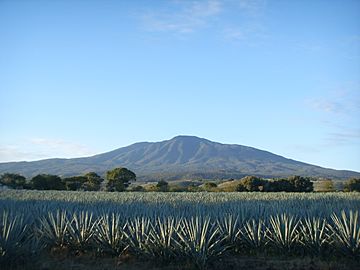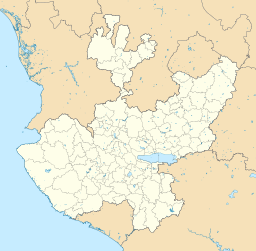Tequila Volcano facts for kids
Quick facts for kids Tequila Volcano |
|
|---|---|
| Volcan de Tequila | |

Tequila Volcano.
|
|
| Highest point | |
| Elevation | 2,920 m (9,580 ft) |
| Prominence | 1,520 m (4,990 ft) |
| Listing | Ultra |
| Geography | |
| Location | Jalisco, Mexico |
| Geology | |
| Mountain type | Stratovolcano |
| Last eruption | ~200,000 years ago |
The Tequila Volcano, also known as Volcán de Tequila, is a large volcano in Mexico. It is found near the town of Tequila in the state of Jalisco. This volcano stands very tall, reaching 2,920 meters (9,580 feet) above sea level.
The Tequila Volcano is a type called a Stratovolcano. These volcanoes are famous for their classic cone shape. They are built up over time by many layers of hardened lava, ash, and other volcanic materials. Stratovolcanoes often have gentle slopes at the bottom that get steeper as you go higher. They usually have a small crater at the very top.
Stratovolcanoes are often found where one tectonic plate slides under another. This process can cause very powerful eruptions. These eruptions can produce fast-moving flows of hot gas and rock, called pyroclastic flows.
Contents
Where is Tequila Volcano Located?
The Tequila Volcano is in Jalisco, Mexico. It is one of the highest peaks in the state. Only Nevado de Colima, Volcán de Fuego, and Cerro Viejo are taller.
This volcano is part of a long line of volcanoes. This line runs next to the Middle America Trench. The trench is a very deep part of the Pacific Ocean. It stretches along the coast from Mexico to Costa Rica.
Scientists have found different types of rock around Tequila Volcano. This shows that different kinds of molten rock, or magma, have erupted there over time.
How Old is Tequila Volcano?
The Tequila Volcano is a stratovolcano, which means it was active for a very long time. We do not know the exact date it was most active. However, its large volcanic field shows it was once very busy. The volcanic field covers about 1600 cubic kilometers.
Today, the Tequila Volcano is considered dormant. This means it is not active right now. It has not erupted for about 220,000 years. If it were to erupt again, it could be a very powerful explosion.
Stratovolcanoes like Tequila Volcano can grow very large. They have a system of channels inside them. These channels bring magma from deep inside the Earth to the surface. They can also have many vents. Lava might break through the sides or flow from cracks. This helps them grow tall and wide.
Tequila Volcano Today
The Tequila Volcano is no longer a danger to the towns nearby. Since it has been inactive for so long, it is now covered in plants and trees. It is also easy for people to visit. You can even drive up to the volcano's crater safely.
The volcano has played a big role in the local culture. Its eruptions left behind rich soil. This soil is perfect for growing blue agave plants. Blue agave is the main ingredient used to make tequila, Mexico's national drink.
The town of Tequila, Jalisco, benefits a lot from the volcano. The lava flows from past eruptions created the fertile land where the town now stands. Many people in Tequila work with agave. They work in the fields, or in distilling, bottling, and selling tequila.
See also
- List of Ultras of Mexico
- Mountain peaks of México
 In Spanish: Volcán de Tequila para niños
In Spanish: Volcán de Tequila para niños



